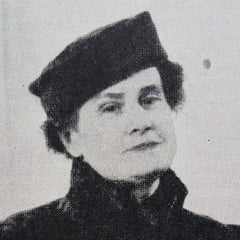Agnes Cleve was one of Sweden’s foremost female artists of the early 20th-Century. A maestro at modernism, Cleve’s vivacious, fast-paced works capture with energy and sophistication a snapshot of the ever-mutating world around her.
Cleve was born to a bourgeois family, which allowed her to receive a thorough education, including in the arts. Cleve attended Valand Art Academy, where she would train under the encouraging eye of Carl Wilhelmson (1866-1928). Wilhelmson was a proponent of equal opportunities for art education for both men and women, ensuring that female students received an education just as nurturing as their male counterparts. Indeed, as well as Cleve, her peers such as Mollie Faustman (1883-1966), Vera Nilsson (1888-1979), and Ellen Trotzig (1878-1949) all achieved successful painterly careers. Clearly, Cleve was part of a flourishing female talent in Swedish art and her own contribution would be sizeable.
After her studies in Sweden were complete, Cleve travelled to Paris to receive further arts education at the Académie de La Palette. This institution focused on the avant-garde artistic styles of modernism, such as cubism, fauvism, and abstract art. These had all been blossoming in popularity since the early 20th-Century and had a focus on innovation and separation from prior painting norms. Paris was the fast-paced beating heart of these artistic developments, and therefore there was nowhere better for Cleve to become wrapped up and swept away in this new modish manner of painting.
Whilst in Paris, Cleve would meet her future husband and fellow painter, Jon Jon-And (1889-1941), a relationship which surely encouraged her artistic appetite. The couple would befriend fellow artists of the modernist movement, such as Richard and Sonia Delaunay, and Wassily Kandinsky (1866-1944). Kandinsky would also visit them when they set up home in Sweden. These connections must also have been sparks to light Cleve’s artistic endeavours alight with painterly inspiration.
Cleve was praised most of all by critics for her use of colour. A discerning blend of vibrant colours brings to life the bustling world around her. Cleve took great inspiration from the fast-paced industry and restless city life in Sweden, particularly when she and her husband were living in Stockholm. Trips abroad to places such as London and the USA, where she lived for a little while, also provided ample ideas.
In the monolithic pillars of steel structures, Cleve adds dramatic edge and metallic gleam through chromatic greys and blues. Peels of clouds emitted from a steam engine congregate in bulbous blue bubbles. Factories emit streaks of white smoke like ribbons which flutter across a harsh industrial scene. Washes of muddied yellow and the bewitching blues of twilight lend a mystery to the scene. Cleve’s works are always bold assertions of life upon her canvases, her modernist brush capturing both the brutality and beauty of the developing world around her. Buildings rise in straight, stark lines, elegant, imperious. A bridge swoops in a glorious bow over rooftops and trees.
Even in her works of still-life and portrait, Cleve retains this modernist, elegant brutality. A painting of her husband chisels his beard in a mass of ochre, carved upon his pasty face. Yet there is a gentleness in the cupping of his hand to his face as he leans his elbow upon a tabletop to read. A man caught in repose is formed of sweeping lines of colour which compose his complexion, his swept-back hair evocating the same grace Cleve appoints to industrial life.
Cleve exhibited frequently in Gummeson’s Gallery in Stockholm, a space dedicated to modernist art. She often did so alongside her husband, however, during the late 1920s she began to make a name for herself as an individual and was able to host a solo exhibition of her work. As well as this Cleve would participate in exhibitions of female artists both in Sweden and, later in the 1930s, within Europe. She was making a name for herself not only in her homeland but across the continent, as one of the great female proponents of modernism.
After her death in 1951, Cleve’s work has been included in exhibitions celebrating Swedish modernism, including a 2014 exhibition dedicated to solely to her. Her importance as a female artist in Sweden continues to be celebrated, and her legacy lives on in the many works by her which remain and are lauded as great examples of modernist art.
1878
Born in Uppsala, Sweden.
1892-1894
Studied at the Technical School, Stockholm, Sweden.
1897-1913
Studied at the Valand Academy of Arts.
1901
Married Ernst Lindesjöö.
1911
Separated from Ernst Lindesjöö.
1914
Studied at the Académie de La Palette, Paris, France. Moved to Bohuslän, Sweden.
1915
Married John Jon-And. Moved to Stockholm, Sweden.
1916
Travelled to New York City, USA.
1917
Held joint exhibition with her husband at Gummeson Art Gallery, Stockholm,Sweden. Exhibited with the Swedish Female Artists’ Association at the Liljevalch Art Gallery, Stockholm, Sweden.
1922-1927
Lived and worked in Gothenburg, Sweden.
1929
Held solo art exhibition in Gummeson Art Gallery, Stockholm, Sweden.
1933
Exhibited with the Exhibition of Works by Women Artists at the Stedelijk Museum, Amsterdam, Netherlands.
1937
Exhibited with The Female Artists of Europe at the Jeu de Paume, Paris, France.
1941
Husband John Jon-And died.
1951
Died. Buried in Uppsala Old Cemetery, Sweden.


